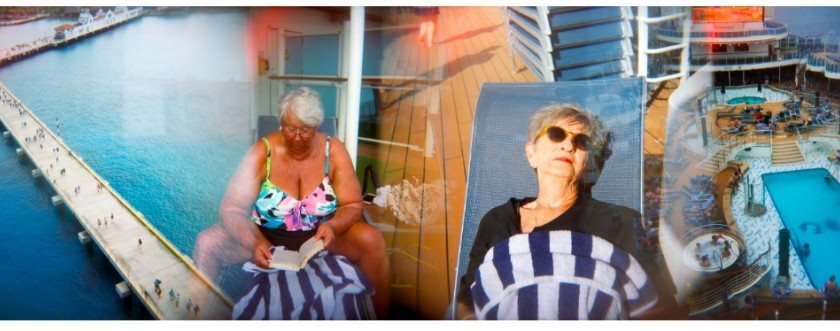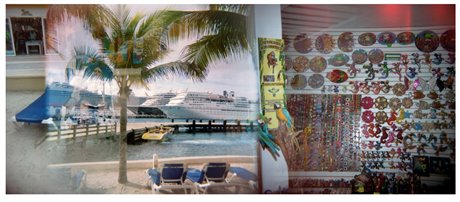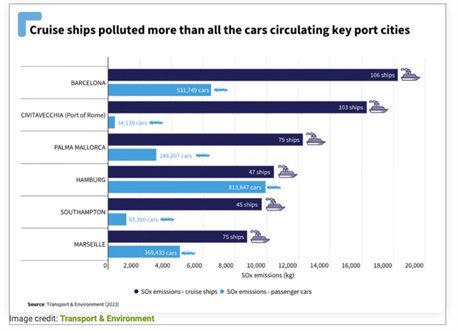Planet Titanic
28 May 2024

By Jeremy Rose
It’s the genteel version of cage diving: cocooned in a steel cage, tourists are wowed by the majesty of nature all the while knowing they’re involved in something many experts argue is environmentally destructive.
But while cage diving to get up close with great white sharks is a niche tourism activity limited to four or five countries around the world, the cruise ship industry is truly global, worth over US$60 billion, and growing.
The average carbon footprint of a cruise ship passenger is eight times that of a land-based tourist.
So, there’s an irony to the growing popularity of so-called last-chance tourism where holidaymakers travel to out-of-the-way locations to see natural wonders before they’re claimed by climate change.
When the chosen mode of transport to reach, say, an Alaskan glacier is a cruise-liner, irony turns to tragedy.
Canadian photographer Sarah Palmer isn’t one to judge.
Her exhibition Wish You Were Here, Auckland Festival of Photography from 29 May to 2 June, is an exploration of cruise ship and vacation culture in a warming world.
Chatting over Zoom from her home in Toronto, Palmer says tourism as it's practiced now isn’t sustainable but that’s a problem that needs to be tackled at an industry, not an individual, level.
“There are steps being taken, but very, very slowly."
Limiting the number of cruise ships allowed to visit the Glacier National Park in Alaska is a move in the right direction,” she says.
“There are steps happening, but it needs to happen at a much quicker pace.”
Palmer’s cruise ship series take in Alaska, the Caribbean, and Vietnam.
Letting the light in
One of her more famous compatriots, Leonard Cohen, wrote: "There’s a crack in everything that’s how the light gets in.”
And Palmer’s camera of choice, the low-cost, plastic large format Holga, is known for letting the light in.

The Holga is something of a cult-classic among film buffs – prized, oddly, for its light leaks, blur and distortions.
For Palmer a big attraction is the ability to manually-wind the film allowing for multi-exposure and the juxtaposition of sometimes jarring scenes.
The multi-exposure, medium format photos are unlikely to find their way into tourism brochures. There’s a ghostly, discomforting quality to them.
In one a palm tree on a white sand beach with three city-sized cruise ships behind, blends into an image of two parrot and another of a store selling tourist trinkets.
Palmer says passengers onboard the ships are often conscious of the outsize carbon footprint of cruise ships and some make an effort to book with companies that have made efforts to be more sustainable.
But cruise companies go to considerable efforts to conceal or sanitize the realities of the countries being visited.

Carnival Cruises has created a man-made port, Mahogany Bay, near the resort town of Roatan, in Honduras. A of gated community for cruise ship tourist with everything from the white sand on its beaches to the trinkets in its stores is trucked in to create a faux authenticity.
The only locals are workers bussed in to serve the tourists. In the unlikely event a passenger strikes up a conversation with one of them, the chance of sea level rise, for example, coming up in conversation is close to zero, Palmer says.
The island states of the Caribbean, like those of Te Moana-nui-a-Kiwa, are among the most at-risk nations on Earth when it comes climate change
Palmer says she’d be keen to take a cruise in the South Pacific to record that reality.
She’s flying Auckland for the opening of the exhibition and will travel to Te Wai Pounamu to photograph some of the retreating glaciers.
“I feel like a walking contradiction most of the time,” Palmer says in relation to her frequent work trips to photograph climate related topics.
But she feels her images help people view the climate crisis in a different way – it’s not just burning forests, and icebergs melting – it’s us and how we’re living our lives.
An iceberg may have sunk the Titanic but a world without icebergs will be anything but safe for the cruise ship industry - or life on Planet Earth for that matter.
Cruise ship facts
- On average, a cruise ship emits 250g of CO2 per passenger kilometre travelled—much more carbon intensity than a short-haul flight.
- 214 cruise ships emitted four times as much sulphur as one billion cars last year.
- A medium-sized cruise ship emits greenhouse gases equivalent to 12,000 cars, and it could dump over 1 billion gallons of untreated sewage into the ocean.
- 63 cruise ships owned by Carnival Corporation emitted more sulfur oxides than all the cars in Europe in 2022.
- Cruise ships accounted for 2% of Christchurch’s gross emissions in 2023.
- Cruise ships generate US$143 billion in economic activity annually and support 1.17 million jobs.
- It’s been estimated cruises emit four times the amount of carbon as flying to a similar destination.

print this story
Story copyright © Carbon News 2024











